Ccr5 32 Study guides, Class notes & Summaries
Looking for the best study guides, study notes and summaries about Ccr5 32? On this page you'll find 29 study documents about Ccr5 32.
Page 3 out of 29 results
Sort by
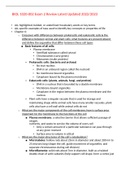
-
BIOL 1020-002 Exam 2 Review Latest Updated 2022/2023,100% CORRECT
- Exam (elaborations) • 21 pages • 2023
-
- $14.99
- + learn more
BIOL 1020-002 Exam 2 Review Latest Updated 2022/2023 • ALL highlighted, bolded, or underlined Vocabulary words or key terms • ALL specific examples of taxa used to identify key concepts or properties of life • Chapter 6: o Crossover with differences between prokaryotic and eukaryotic cells & the difference between animal and plant cells; what features are present/absent and define the organelles that differ between these cell types ▪ Basic features of all cells: • Plasma memb...
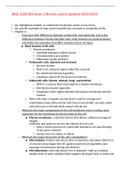
-
BIOL 1020-002 Exam 2 Review Latest Updated 2022/2023,100% CORRECT
- Exam (elaborations) • 21 pages • 2023
-
- $15.49
- + learn more
BIOL 1020-002 Exam 2 Review Latest Updated 2022/2023 • ALL highlighted, bolded, or underlined Vocabulary words or key terms • ALL specific examples of taxa used to identify key concepts or properties of life • Chapter 6: o Crossover with differences between prokaryotic and eukaryotic cells & the difference between animal and plant cells; what features are present/absent and define the organelles that differ between these cell types ▪ Basic features of all cells: • Plasma memb...

-
MICRO 100 All Questions and answers Latest copy
- Exam (elaborations) • 18 pages • 2021
-
- $11.99
- + learn more
MICRO 100 All Questions and answers PRE-Exam 1. True or False: A virus is considered a microorganism. False. Viruses are not living and as such are not considered microorganisms. Viruses can, however, be classified as microbes, a more general term that includes microorganisms and viruses. 2. What is the smallest biological unit of life? A cell. 3. At a generalized level, all cells are comprised of what? Macromolecules* *A student may also answer: Proteins, Lipids, Nucleic acids and...

-
Portage Learning BIOD 171 Module 6 Exam Module 6
- Exam (elaborations) • 11 pages • 2022
-
- $15.49
- + learn more
Portage Learning BIOD 171 Module 6 Exam Module 6 1. True or False. Because the genome is contained within an enclosed space, (much like the nucleus of a cell) viruses are classified as eukaryotic. False. Viruses are neither eukaryotic nor prokaryotic. 2. Describe the two basic components of a virus. A virus has (1) genomic material comprised of either DNA or RNA and (2) a capsid, a membrane-like protective structure that contains the genetic material, similar to the nucleus of a euka...
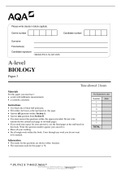
-
AQA A LEVEL BIOLOGY PAPER 3 2021
- Exam (elaborations) • 40 pages • 2022
-
- $13.49
- + learn more
Distribution of this document is illegal Please write clearly in block capitals. Centre number Candidate number Surname Forename(s) Candidate signature I declare this is my own work. A-level BIOLOGY Paper 3 Time allowed: 2 hours Materials For this paper you must have: • a ruler with millimetre measurements • a scientific calculator. Instructions • Use black ink or black ball-point pen. • Fill within the boxes at the top based on this page. • Answer all questions withi...
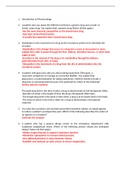
-
pharm_at_proc_review.docx
- Exam (elaborations) • 166 pages • 2022
-
- $25.49
- + learn more
1. Introduction to Pharmacology 2. A patient asks you about the difference between a generic drug and a trade- or brand- name drug. You explain that a generic drug (Select all that apply.) -has the same chemical composition as the brand-name drug. -may have several brand names. -is usually less expensive than a brand-name drug. 3. Distribution is the movement of a drug by the circulatory system to its intended site of action. -Metabolism is the change that occurs in a drug into a more ...
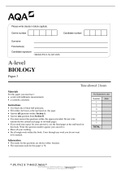
-
AQA A LEVEL BIOLOGY PAPER 3 2021
- Exam (elaborations) • 40 pages • 2022
-
- $12.49
- + learn more
Distribution of this document is illegal Please write clearly in block capitals. Centre number Candidate number Surname Forename(s) Candidate signature I declare this is my own work. A-level BIOLOGY Paper 3 Time allowed: 2 hours Materials For this paper you must have: • a ruler with millimetre measurements • a scientific calculator. Instructions • Use black ink or black ball-point pen. • Fill within the boxes at the top based on this page. • Answer all questions withi...
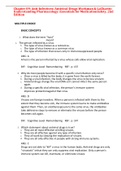
-
Chapter 09: Anti-Infectives: Antiviral Drugs Workman & LaCharity: Understanding Pharmacology: Essentials for Medication Safety, 2nd Edition,100% CORRECT
- Exam (elaborations) • 33 pages • 2021
-
- $17.49
- + learn more
Chapter 09: Anti-Infectives: Antiviral Drugs Workman & LaCharity: Understanding Pharmacology: Essentials for Medication Safety, 2nd Edition MULTIPLE CHOICE BASIC CONCEPTS 1. What does the term “host” mean? a. The person infected by a virus. b. The type of virus known as a retrovirus. c. The type of virus known as a common virus. d. The type of infection that occurs only in immunosuppressed people. ANS: A A host is the person infected by a virus whose cells allow viral replic...
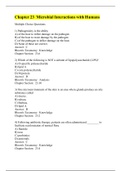
-
Chapter 23 Microbial Interactions with Humans,100% CORRECT
- Exam (elaborations) • 25 pages • 2021
-
- $18.49
- + learn more
Pathogenicity is the ability A) of the host to inflict damage on the pathogen. B) of the host to resist damage by the pathogen. C) of the pathogen to inflict damage on the host. D) None of these are correct. 2) Which of the following is NOT a subunit of lipopolysaccharide (LPS)? A) O-specific polysaccharide B) lipid A C) core polysaccharide D) M protein 3) One microenvironment of the skin is an area where glands produce an oily substance called A) mucus. B) sebum. C) fimbrae. D...

That summary you just bought made someone very happy. Also get paid weekly? Sell your study resources on Stuvia! Discover all about earning on Stuvia


